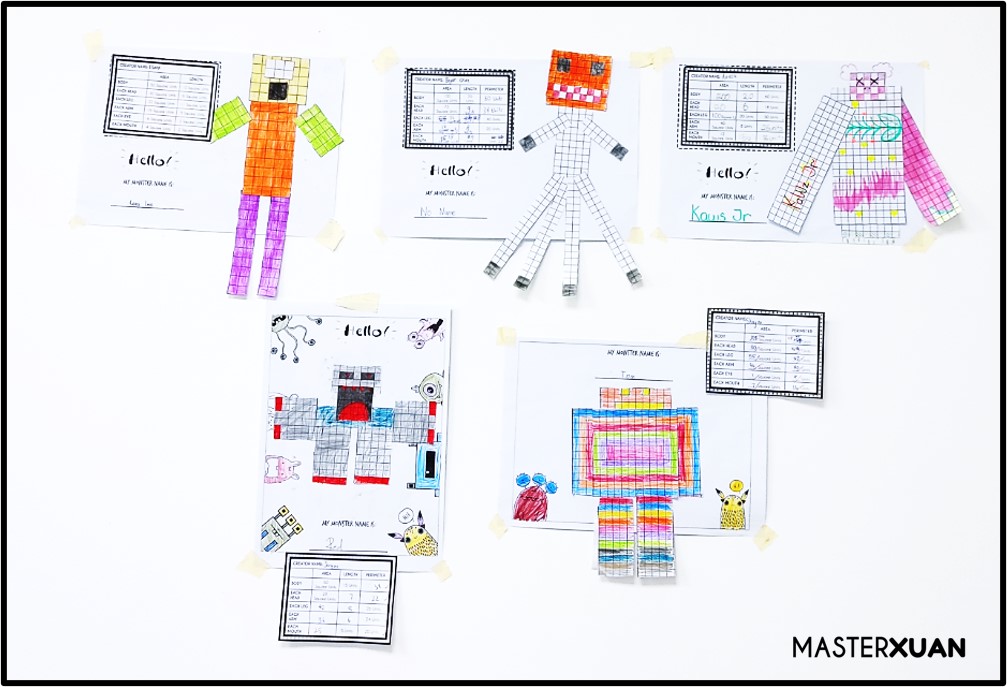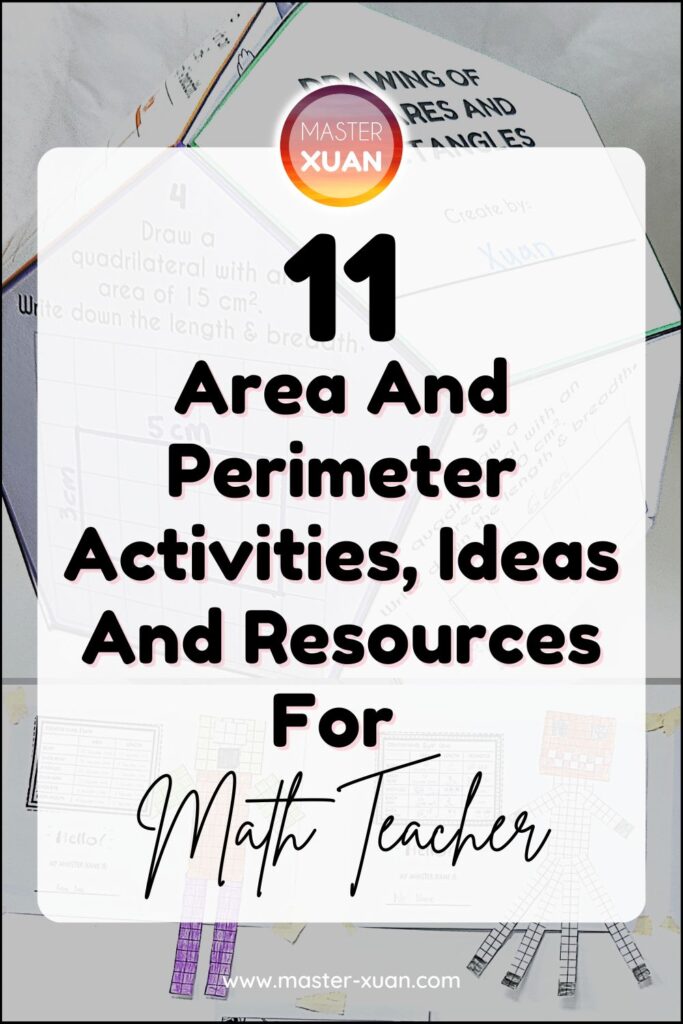Are you finding area and perimeter activities? Then continue reading for more fun activities, great ideas, and resources to add to your lesson plans.
Area and perimeter are great for visual learners as the questions are usually able to translate into images. This means that there are lots of possibilities for hands-on activities. Before proceeding to word problems, use different ways to learn this math skill.
Students need to have a solid understanding of area and the concepts of perimeter to prevent mixing up these 2 math concepts.
By using this variety of area and perimeter activities, students wouldn’t be bored anymore!
1) Create A Monster: Cut & Paste Activity
Let your students have fun and use their creativity with this Create A Monster activity as they practice with area and perimeter. This area and perimeter activities for 4th grade are ideal for Halloween but can also be used all year round.

Ok, here is how it works.
Your students will create a monster with a body, heads, legs, arms, eyes, and mouths that have a specified area or perimeter.
In the resource, there are 8 different categories with different information and measurements. For example, given perimeter, students need to come up with the dimension. With the different possibilities and placement of the 2-D shapes, students are able to create their unique monsters.
This means that even if students get the same task card, they will still end up with different creations!
So you have many ways you can use this math resource.
This makes it a great bulletin board display.
Hear what other teacher had said:
“Fantastic hands-on activity for teaching area and perimeter. Students were engaged and each had a final product unique to each student.” ~ Christine L
2) Math Tiles
I think math tiles are like puzzles and I love workable puzzles!
This digital aspect means you don’t have to worry about missing tiles and messy tables. The best part? It is self-checking and NO PREP!

3) Dodecahedron Craft
This 3-D paper craft will amaze or hook your students. This is a unique way to practice the area and perimeter of rectangles and squares.
Students will need to draw a square or rectangle on a grid given the area. Then indicates the length, breadth, and perimeter. With the grid, students can also use their knowledge of tiling to help them.
Since an area of a rectangle can be formed by different combinations of length and breadth, students may have different answers. However, an answer key is still provided to act as a reference resource.

Okay, now the craft part.
The dodecahedron has 12 sides, with 11 sides requiring students to solve math problems.
Your students will be engaged with this 3D dodecahedron math craft as it allows them to solve, draw, color (optional), cut, fold, and glue/stapler.
They are perfect for kinesthetic learners and students who love to get their hands busy!
I’m sure your students will enjoy this new creative way to practice area and perimeter skills!
4) Digital Area and Perimeter Task Cards

Students will need to find the perimeter and area of irregular shapes with this print and digital resource. This is best used after students learn the concept of area and have a clear understanding of the concept of perimeter.
You can use this online for the self-checking function and print the area and perimeter worksheets to act as a recording sheet.
This is perfect for independent work, math center or stations, and is also suitable as a revision for fourth graders. This can also be used as a quiz to test students’ understanding.
5) Area and Perimeter Songs
They make a great hook or after teaching area and perimeter to 3rd graders, use this for a quick recap. The multisensory is great for auditory and visual learners.
And of course, everyone enjoys a good song.
Perimeter Around the Area by Bazillion
This song uses 2 cats to explain the concepts.
Area and Perimeter by Flocabulary
This one is a rap about the astronaut and his pet dog on Mars! The units used are unit squares and feet.
6) Block Letter Names
Students are going to draw their names using squares in a grid or graph paper.
First, each child will design their name on a rough paper or whiteboard. You can also let them use a pencil to lightly traces their name on the graph paper right from the start.
Once they are happy with their design, ask students to trace the letters with the marker and count the perimeter as they do so. Record the perimeter of each letter at the bottom.
Next, color in with crayons or colored pencils. As students fill in the square units, they can count the number of squares to count the area of the letters. Similarly, record the area of each letter at the bottom.
7) Scavenger Hunt
Measure objects in the classroom.
Then provide students with the area, perimeter, or dimensions of the object and ask students to find the mystery objects.
Student-centered learning game
You can also ask students to create the “treasure”. Students will need to record the area or perimeter of rectangular items. Then they can match the area or perimeter with the actual item.
8) Who Has The Greatest Area?
Materials: graph paper, a pair of dice, and different colored crayons, pencils, or markers.
Players: 2 – 3
How to play:
Players have to take turns rolling the dice.
One dice is the length and the other is the breadth.
Based on the dimension, the player will draw the rectangle or squares on the grid paper.
The player will need to multiply the numbers on the dice and write the area within the shape.
When there is no more room on the page, or once the time is up, the game ends.
Players need to add up their area and the player with the greatest area wins!
9) Use Picture Books
Pictures books that teach math skills help provides examples of real-world applications.
If you want to show the whole class or a small group the picture book, searching read-aloud from YouTube may be a good idea.
Anyway, here are the 2 commonly recommended picture books for introducing area and perimeter.
To introduce students to dimensions with different measurements, you can consider reading Perimeter, Area, and Volume by David Adler to your class.
Or a simpler way, watch this read aloud.
It even has time stamps so you can skip to certain math skills. It introduces different units of measurement, including customary units of measurement and metric units. There is also mention of the circumference of a circle.
Another popular picture book is Spaghetti And Meatballs by Marilyn Burns. This read-aloud video took out the text, animated it, and make it bigger so it is easier for your students to read it. This great book talks about seating arrangements which makes it a great way to connect math with the real world.
At the end of the video, they even show you an extension activity that you can do with your students after reading the book. So if you are showing this video, do stop it once the story ends.
10) Use Manipulatives
You can use square tiles, square post-its, or square origami paper as manipulatives when teaching this concept. Or you can simply make squares using construction paper. You can also use pattern blocks to teach perimeter of polygons.
With something that students can shift around and using visual cues, kinesthetic learners can learn better.
You can form composite figures with the squares post-its. Then ask students to write down the number near the sides to count the perimeter.
Or you can use other manipulatives to put outside of a shape to count the perimeter.
Alternatively, use different color tiles to form the outline to find the perimeter of a polygon.
There are many areas and perimeter activities that you can do with manipulatives.
11) Motor Exploration
Another way to engage students is to make use of students’ whole body and gross motor skills. Then connect gross motor exploration to abstract thinking.
One activity is to push tables together and ask students to walk around them to count the perimeter. This also helps students to understand better the meaning of perimeter. They can also count the area of tables and the amount of space they occupied.
Another way is to flash questions on the screen and ask students to identify whether is the questions asking for area or perimeter. Students need to form the letter A or P with their bodies to represent area and perimeter respectively.
Final Thoughts
I hope you get some new ideas and fun ways to make the lesson much more engaging and the resources to ensure students have a better understanding of the concepts of area and perimeter.
Choose 1 engaging way to try so that learning area and perimeter of different shapes will be more fun and memorable.
If the first time didn’t work out, try another one the next day.
So which are your favorite area and perimeter activities? Let me know.
Read: The Top 3 Strategies For Teaching Math In Small Groups Or Classes
Here are some pins that you can save to bookmark this post. Save them to your Pinterest Board now! ↓








